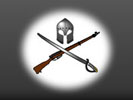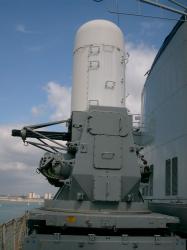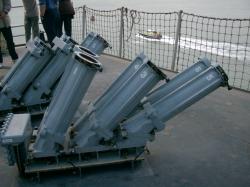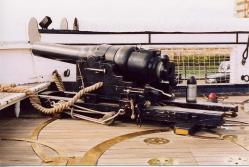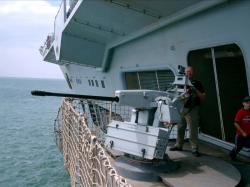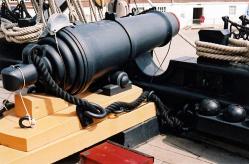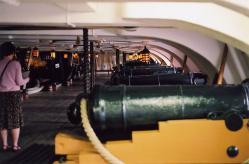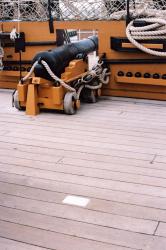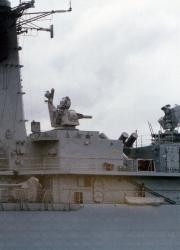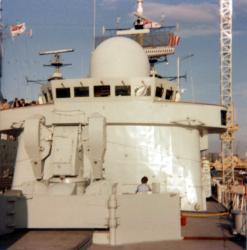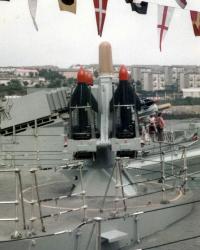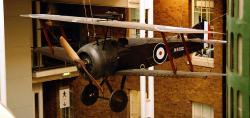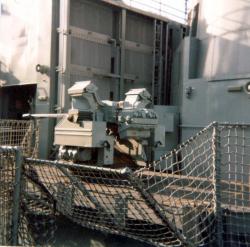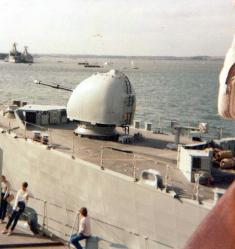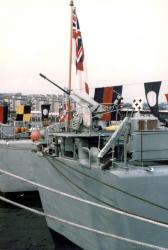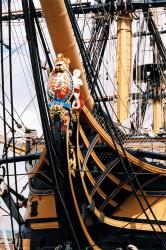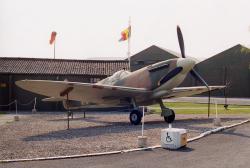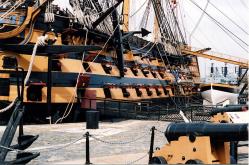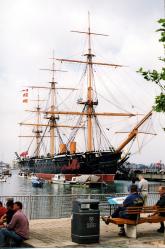Translate this Page
Recent images :
- International Harvester M5 halftrack
- Dassault Mystère Mk IVa number 146
- Ark Royal, Anti-ship missile defence gun.
- RAF Series 2 Land Rover
- Lightweight, air portable Land Rover
- Daimler Ferret Mk 1/2 Armoured Car
- RAF Mountain Rescue Series 3 Land Rover
- French Bronze 6 pounder cannon
- Farsley South African War Memorial
- Farsley War memorial
Images of ship-borne Weapons Systems
Click on the entry for a larger image and details, or click to go back to the previous index
The Raytheon Systems, Phalanx Close In Weapons System was first developed in 1977, and began to be deployed in the US Navy from 1980. It fires 20mm shells and can be operated fully automatically using both radar and Forward-looking Infra-Red (FLIR) t...
Portsmouth Naval Dockyard, July 2003
One of the chaff dispensers on board the Ark Royal, designed to eject huge quantities of aluminium foil in a cloud to confuse a radar-guided missile attack.
Portsmouth Naval Dockyard, July 2003
The bow 110lb, breech-loading Armstrong gun on board HMS Warrior.
Portsmouth harbour, August 2002.
Based on the Oerlikon 20mm cannon, the GAM BO1 is fitted to most ships of the Royal Navy for smaller-caliber gunnery duties. It has a range of 2km and a rate of fire up to 900 rounds per minute.
Portsmouth Naval Dockyard, July 2003
A close-up of one of the Victory's 68-pounder carronade guns (reproduction) mounted on the forecastle. The shot garland with 2 68 pound round shot can be seen to the right.
Portsmouth Historic Dockyard, August 2002
A view of the middle gundeck of the Victory, showing the cramped conditions in which the crew would have had to fight the huge 24-pounder cannon currently run out.
Portsmouth Historic Dockyard, August 2002
A section of the Quarterdeck showing, in the foreground (and in the detail picture), a brass plaque marking the point where admiral Nelson fell during the Battle of Trafalgar to musket fire from the Redoutable. He died later, on the orlop deck with t...
Portsmouth Historic Dockyard, August 2002
This Dutch-built Close in Weapons System (CIWS) provides a fully autonomous weapon designed to shoot down missiles and aircraft from between 350m and 1500m of the host ship. It mounts a 7 barrel 30mm Gatling gun capable of 4,200 rounds per minute and...
Location and date unknown, probably early 1990's
Two views of the Sea Dart medium range area defence anti-aircraft missile system in it's dormant, unloaded state. The two outer mounting points take missiles which slide up from the magazine below the mounting which then elevate and rotate to track t...
location and date unknown
A close range anti-aircraft missile used by the British Royal Navy. Its guidance was by radio-controlled visual tracking and its propulsion was by solid fuel. It was fitted to Rothesay Class, Leander Class and Amazon Class Frigates, also in County cl...
Location unknown, 1980's
The Sopwith Camel (so called because of the hump in the forward fuselage between the pilot and the propeller) arrived late in the First World War, entering service on the western front on 4th July 1917, to late to prevent the 'happy time' in April th...
Imperial War Museum, London, England. October 2003.
Two views of the Royal Navy's twin 30mm GCM - A03 mounted Oerlikon guns as fitted to Type 22 frigates and other ships such as LPD's. Each gin has a rate of fire of 650 rpm and a range of 3000m .
Location and date unknown, probably early 1990's
The ‘standard’ 4.5 inch/114mm gun fitted in Type 42 Destroyers, Batch 3 of Type 22 Frigates and all Type 23 Frigates. Capable of firing a range of ammunition at up to 25 rounds per minute out to a maximum range of 17 miles.
location unknown
The actual ship concerned is not known, but our best guess is that this is the stern of a Leander class Frigate photographed in 1984 [or 1983] a single barrel 20mm being part of the post Falklands additional armament.
Location unknown, 1980's
